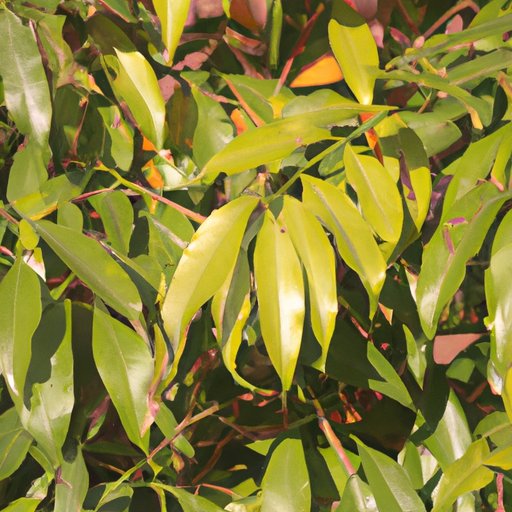Introduction
Green leaves are the hallmark of a healthy, thriving plant. Leaves are crucial for photosynthesis, which is how plants convert sunlight into the energy they need to grow, survive, and reproduce. Without leaves, a plant cannot make its own food, and it will eventually die. However, sometimes leaves can turn yellow, which can be a sign of trouble. In this article, we’ll explore why plants’ leaves turn yellow and what you can do about it.
Q&A: Why Do Plant Leaves Turn Yellow?
Sometimes, leaves can turn yellow as part of a normal growth cycle. For example, deciduous trees shed their leaves in the fall as they prepare for winter. However, if a plant’s leaves are turning yellow outside of its normal growth cycle, it’s usually a sign that something is wrong.
A common cause of yellowing leaves is nutrient deficiencies. Plants need a variety of nutrients to grow and thrive, including nitrogen, phosphorus, potassium, magnesium, and iron. If a plant isn’t getting enough of these nutrients, its leaves may turn yellow. Different nutrients affect different parts of the plant. For example, nitrogen deficiencies often show up as yellowing leaves at the bottom of the plant, while iron deficiencies tend to affect newer growth at the top.
However, nutrient deficiencies are not the only potential cause of yellowing leaves. Plants can also be affected by diseases, pests, and environmental stressors such as drought, excessive heat or cold, or too much or too little light. Identifying and addressing the underlying cause of yellowing leaves is crucial for preventing further damage to the plant.
Diagnosing and Troubleshooting Yellowing Leaves
If you notice that your plant’s leaves are turning yellow, your first step should be to diagnose the problem. Start by checking the soil to see if the plant is getting enough water and nutrients. Consider the plant’s environment, including the amount of sunlight it’s getting, the temperature and humidity, and any potential sources of stress such as pests or disease. Look for any other signs of damage, such as spots or wilting.
Once you’ve identified the possible causes of yellowing leaves, you can take steps to address them. For nutrient deficiencies, you may need to add fertilizers specifically designed to address the missing nutrients. For diseases and pests, you may need to treat the plant with pesticides or fungicides. For environmental stressors, you may need to adjust the plant’s environment, such as by moving it to a more suitable location or adding a shade cloth to protect it from excess sun.
If you’re not sure what’s causing your plant’s yellowing leaves, try starting with the most common issues and working from there. Keep in mind that some plant species are more susceptible to certain problems than others, so it’s important to do your research and understand the specific needs of your plants.
Understanding Environmental Factors and Plant Health
Environmental factors such as temperature, humidity, and rainfall can have a significant impact on plant health. In areas with extreme weather conditions, plants may be more prone to yellowing leaves or other damage. For example, plants in desert climates may struggle with drought stress, while plants in humid areas may be more susceptible to fungal diseases.
Different plant species also have different ways of producing and storing chlorophyll, which is the pigment that gives leaves their distinctive green color. Some plants produce more chlorophyll than others, and some are able to store more of it, which allows them to better withstand stress and damage. Understanding these differences can help you choose the right plants for your climate and take better care of them.
Historical Perspective on Plant Science and Yellowing Leaves
The study of plant science has a long and fascinating history, from ancient botanical drawings to modern genetic engineering. Over the centuries, researchers have made significant discoveries about plant biology and the various factors that can affect plant health.
By talking to experts in the field of plant science, we can gain a deeper understanding of why plants’ leaves turn yellow and how we can help prevent it. These interviews can provide a compelling narrative of the evolution of plant science and inspire gardeners to keep learning and experimenting with new techniques.
Prevention and Tips for Keeping Plants Healthy
Preventing yellowing leaves starts with good plant care practices. Here are some tips to help keep your plants healthy:
- Choose the right plants for your climate and soil type
- Water your plants regularly and deeply, but be careful not to overwater
- Fertilize your plants with a balanced fertilizer that includes all the necessary nutrients
- Prune your plants regularly to promote healthy growth and prevent disease
- Monitor your plants for signs of pests or disease and treat them promptly if necessary
Conclusion
Yellowing leaves can be a sign of a variety of problems, from nutrient deficiencies to disease to environmental stressors. However, with careful observation and diagnosis, you can often identify the underlying cause and take steps to address it before it causes serious harm to your plants. By following good plant care practices and staying curious about the fascinating world of plant science, you can help your plants thrive and enjoy the beauty and benefits of a healthy garden.
